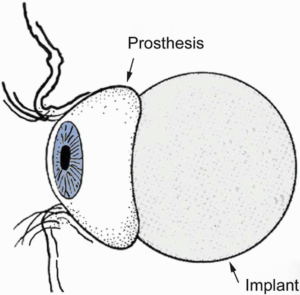One of the most difficult aspects of losing an eye is psychological. For many patients, the first thing that pops into their mind is, “What will I look like.”
Fortunately, with a good ocular prosthesis, the loss of an eye will hardly be noticeable to the average passerby.
Over the last 20 years, the amount of time between surgery and the beginning of cosmetic rehabilitation has decreased from six weeks to typically less than four. In an effort to ease the psychological trauma of enucleation, Dr. Paul Finger has had great success reducing this timeframe even further. He has found most patients tolerate a temporary prosthesis in as little as five days. That means instead of waiting up to four weeks, they can have a temporary artificial eye inserted as soon as the bandage is removed. This greatly eases their psychological transition and facilitates a quick return to a sense of normalcy.
Dr. Finger co-authored a 2006 study published in Optometry – Journal of the American Optometric Association that showed patients generally did well with early insertion of a temporary prosthesis, and all of the study patients preferred the early cosmetic rehabilitation associated with placement of an ocular prosthesis at the time the bandage was removed.
The study focused on 12 patients who had large intraocular malignancies and were treated by enucleation. Immediately after bandage removal, the patients saw themselves in a mirror and were offered placement of a relatively small ocular prosthesis. Patients were asked if they preferred their appearance with or without the prosthesis.
 Eight patients tolerated introduction of the prosthesis at the time their pressure dressing was removed – three to five days after surgery. Due to discomfort, four patients did not receive their prostheses until their second postoperative visit – day 12 or 13. The manipulation at prosthesis insertion and subsequent wearing was found to have no effect on wound closure, final prosthetic fittings, or movement of the permanent prosthesis.
Eight patients tolerated introduction of the prosthesis at the time their pressure dressing was removed – three to five days after surgery. Due to discomfort, four patients did not receive their prostheses until their second postoperative visit – day 12 or 13. The manipulation at prosthesis insertion and subsequent wearing was found to have no effect on wound closure, final prosthetic fittings, or movement of the permanent prosthesis.
All of the patients preferred the appearance of the temporary prosthesis.
“Other than the temporary discomfort reported during four initial attempts at prosthesis insertion, there were no complications related to early cosmetic rehabilitation. There was no opening of the operative wound, infection, or hemorrhage. All patients were pleased with the cosmetic benefit afforded by early introduction of the prosthesis. They all made a stated preference for their appearance with the temporary prosthesis compared with their ‘pink eye’ with the conformer.”
Now, with 10 years of clinical experience supporting the study, almost every patient can be fitted with a temporary eye until their socket is ready for a permanent prosthetic solution.
The study underscores Dr. Finger’s commitment to patient centered care. This means not only treating the physical condition, but also considering the patient’s state of mind. The goal is not only to eradicate the cancer, but to help the patient to return to as normal and fulfilling life as possible.











Interesting article. It’s a good thing that eye prosthesis can help blind people live a normal life. It definitely gives them a higher self-esteem. If I were in the same situation, I would definitely consider wearing one as well. Thanks.
We certainly agree! Prosthesis can make quite a positive difference as enucleated patients adjust to their new lives after surgery.
The before and after pictures of these prosthetic eyes is really impressive. It is quite hard to tell they are even fake. The technology seems to have improved a lot.
Indeed, Kenneth! It makes a great deal of improvement in quality of life after enucleation!